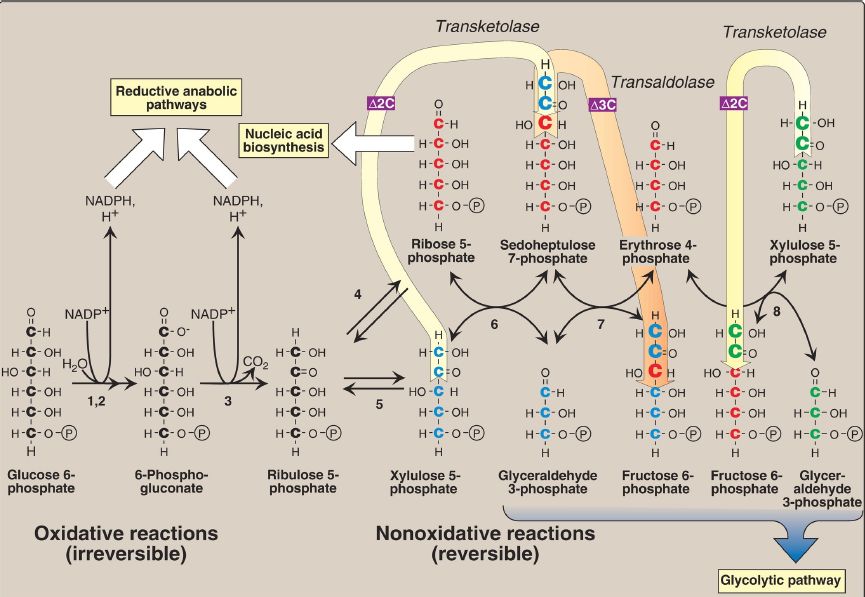
Irreversible Oxidative Reactions
 المؤلف:
Denise R. Ferrier
المؤلف:
Denise R. Ferrier
 المصدر:
Lippincott Illustrated Reviews: Biochemistry
المصدر:
Lippincott Illustrated Reviews: Biochemistry
 الجزء والصفحة:
الجزء والصفحة:
 27-9-2021
27-9-2021
 2026
2026
Irreversible Oxidative Reactions
The oxidative portion of the pentose phosphate pathway consists of three irreversible reactions that lead to the formation of ribulose 5-phosphate, CO2, and two molecules of NADPH for each molecule of glucose 6-phosphate oxidized (Fig. 1).
This portion of the pathway is particularly important in the liver, lactating mammary glands, and adipose tissue for the NADPH-dependent biosynthesis of fatty acids ; in the testes, ovaries, placenta, and adrenal cortex for the NADPH-dependent biosynthesis of steroid hormones ; and in red blood cells (RBC) for the NADPH-dependent reduction of glutathione .

Figure 1: Reactions of the pentose phosphate pathway. Enzymes numbered above are: (1, 2) glucose 6-phosphate dehydrogenase and 6-phosphogluconolactone hydrolase, (3) 6-phosphogluconate dehydrogenase, (4) ribose 5-phosphate isomerase, (5) phosphopentose epimerase, (6, 8) transketolase (coenzyme: thiamine pyrophosphate), and (7) transaldolase. Δ2C = two carbons are transferred from a ketose donor to an aldose acceptor in transketolase reactions; Δ3C = three carbons are transferred in the transaldolase reaction. This can be represented as: 5C sugar + 5C sugar 7C sugar + 3C
sugar 4C sugar + 6C sugar. NADP(H) = nicotinamide adenine dinucleotide phosphate; = phosphate; CO2 = carbon dioxide.
A. Glucose 6-phosphate dehydrogenation
Glucose 6-phosphate dehydrogenase (G6PD) catalyzes the oxidation of glucose 6-phosphate to 6-phosphogluconolactone as the coenzyme NADP+ gets reduced to NADPH. This initial reaction is the committed, ratelimiting, and regulated step of the pathway. NADPH is a potent competitive inhibitor of G6PD, and the ratio of NADPH/NADP+ is sufficiently high to substantially inhibit the enzyme under most metabolic conditions. However, with increased demand for NADPH, the ratio of NADPH/NADP+ decreases, and flux through the pathway increases in response to the
enhanced activity of G6PD. [Note: Insulin upregulates expression of the gene for G6PD, and flux through the pathway increases in the absorptive state .]
B. Ribulose 5-phosphate formation
6-Phosphogluconolactone is hydrolyzed by 6-phosphogluconolactone hydrolase in the second step. The oxidative decarboxylation of the product, 6-phosphogluconate, is catalyzed by 6-phosphogluconate dehydrogenase. This third irreversible step produces ribulose 5-phosphate (a pentose sugar– phosphate), CO2 (from carbon 1 of glucose), and a second molecule of NADPH (see Fig. 1).
 الاكثر قراءة في الكيمياء الحيوية
الاكثر قراءة في الكيمياء الحيوية
 اخر الاخبار
اخر الاخبار
اخبار العتبة العباسية المقدسة


